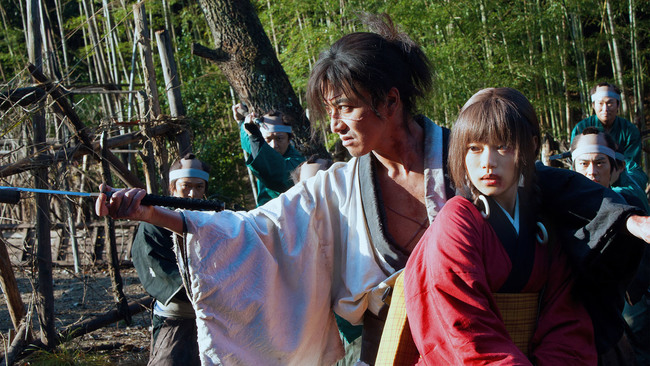Cannes 2017: Takashi Miike’s Blade of the Immortal

“Although the word ‘overkill’ can be used to describe practically any of Takashi Miike’s films,” begins Maggie Lee in Variety, “in some ways, the director’s brutal, 2½-hour sword-fight fantasy Blade of the Immortal takes the notion to another level. For the ultra-prolific 56-year-old workhorse, his 100th feature is executed with ‘business as usual’ craftsmanship. Miike’s first samurai film since Hara-kiri: Death of a Samurai (2011) and 13 Assassins (2010) marks a clear departure from the measured classicism of those two films. Instead, the story of a Wolverine-like swordsman with the capacity to self-heal delves into an aesthetic of pain, showing a twisted fascination in the hero’s bloody gashes and mutilations.”
“Adapted from Hiroaki Samura’s manga of the same name, it follows Manji (Takuya Kimura), a samurai during the Shogunate era who can not die,” explains Jordan Hoffman in the Guardian. “Prick him and he will bleed, impale him with a humongous sword and he will emit a gruesome gurgle, but with time (and without any novocaine) his innards will put themselves back where they ought to be, enabling him to continue slaying his enemies.” And “the fun really shines when the film revels in the outlandish weapons: enormous double-pronged swords, an axe that looks more like a sharp anvil, blades attached to staffs, blades attached to chains, shurikens for all occasions, etc. Each gets its own theatrical introduction.”
“The story, a kind of Eastern cousin to Logan, betrays episodic comic-book roots,” writes the A.V. Club’s A. A. Dowd. “What we’re watching is essentially a string of limb-hacking, blade-slicing showdowns, as Manji and teenage charge Rin (Hana Sugisaki) encounter one heavy after another. It’s neither as powerful nor as awesome as Miike’s 13 Assassins, a towering throwback masterpiece in his hefty oeuvre. But it is a nonstop barrage of kinetic, gory-goofy fun—and further proof that of all the genres he dabbles in, samurai cinema is the one that brings out the grandest entertainer in Miike. Here’s to 100 more.”
“Watching the film is like binging on a number of back-issues you picked up all at once,” adds Ben Croll at IndieWire. “It may not be the most wholly successful approach, but leave it to Miike for coming up with something new. A hundred movies in, and he’s invented a new genre—the comic books movie.”
“It’s the lack of development of Rin’s character (she’s a one-note vulnerable but feisty child-woman throughout), combined with a story lull around an hour in, that’s responsible for a mid-term weakening in the audience grip on a film that’s at least a quarter of an hour too long,” suggests Lee Marshall in Screen. “In the end, though, it’s the bravura fight sequences . . . where Miike is on fine form, never losing his sense of humor, or sense of character, even as yet another axe is embedded in yet another skull.”
“Blade of the Immortal shows Miike to have lost none of the madcap energy and wit that characterize his best work,” writes Harry Windsor for the Hollywood Reporter. “And while this is not that, it’s still got more style to burn than almost any recent Hollywood actioner. . . . There's nothing of the factory product about this enjoyably outrageous splatter-fest, of course; one can only dream of the battered Burbank execs taking the lead from their Japanese counterparts and handing Miike the reins to, say, Suicide Squad 2.”
Update, 5/20: “There’s a confusing subplot involving the Itto-ryo’s acceptance in society, and it’s probably 45 minutes too long, but you don’t come to a samurai bloodbath for plot,” writes Jada Yuan at Vulture. “You come to watch the screen turn red, and to watch the many inventive ways people can die. In fact, we counted, and the movie showcases a whopping 28 different ways to die.” The list follows.
Update, 5/22: “Best of all is Sota Fukushi as Kagehisa Anotsu, the dark mastermind of the killer dojo,” writes Daniel Kasman in the Notebook. “An alabaster god of feminine features lanky and long, with a dark glare of vacuous menace, his couture is completed with a periwinkle blue kimono. ‘You are a heretic just like me,’ Kagehisa tells Rin, and with this statement Blade of the Immortal performs its final blow, casting orphaned heroine, immortal hero and rebel villain all in the same status of the aggrieved, the outcasts. All three, Manji, Rin and Kagehisa, desire to attain satisfaction by bloodshed—some kind of relief. What remains though, after all who can be killed are dead, is only sorrow. As Kagehisa predicts in the final fight, ‘fear of the warrior’s sword will revive in these lands.’”
Update, 5/23: The Notebook’s posted Daniel Kasman and Kurt Walker’s video interview with Miike (8’40”).
Cannes 2017 Index.For news and items of interest throughout the day, every day, follow @CriterionDaily.



